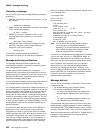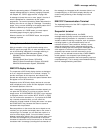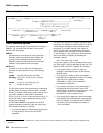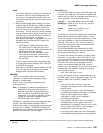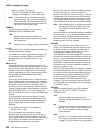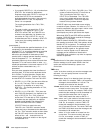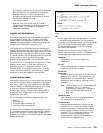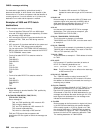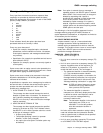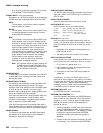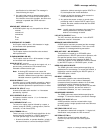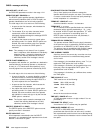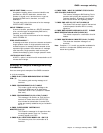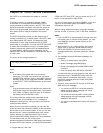CMSG—message switching
If a destination is specified by /opid without termid, it
becomes termid/opid, in which termid is the identifier of the
first terminal or LU to which an operator with that identifier is
currently signed on. If no such terminal or LU is found, the
destination is not valid and the operator is notified.
Examples of 3600 and 3770 batch
destinations
These examples assume the following:
Terminal identifiers T36n and T37n are 3600 logical
units and 3770 batch logical units respectively; all others
are start-stop or BSC terminals.
LDC mnemonics DS and LP have been defined for the
system and T361, T362, and T363 during resource
definition.
LDC mnemonic P1 has been defined for the system and
T371, T372, and T373 during resource definition.
You can also use the TYPETERM LDCLIST attribute of
RDO to define these mnemonics instead of the DFHTCT
TYPE=TERMINAL macro shown.
Terminal list table DFHTLTL3 contains entries for:
T361*DS
T362*DS/OP1
T362*DS/OP2
T363
T371*P1
T372*P1/OP1
T372*P1/OP2
T373
T40.
Terminal list table DFHTLTL4 contains entries for:
T361*DS
T362*DS/OP1
T362*DS/OP2
T363
T40.
1. R=T361*DS
Route message to terminal identifier T361 qualified by
LDC mnemonic DS.
2. R=(T361*DS,T362*DS/OP1,T363,T371*P1,
T372*P1/OP1,T373,T40)
Route message to:
T361 and T362 qualified by LDC mnemonic DS
T363, using the default LDC
T371 and T372 qualified by LDC mnemonic P1
T373 console keyboard/printer
T40, which is a start-stop or BSC terminal.
T362 and T372 require that an operator with
identification OP1 be signed on before the message can
be sent.
Note: The default LDC mnemonic for T363 must
indicate the same device type as LDC mnemonic
DS.
3. R=ALL*LP
Route message to all terminals (3600, 3770 batch and
interactive logical units, start-stop, and BSC) with all
3600 destinations qualified by mnemonic LP. LP is
ignored for start-stop and BSC destinations.
4. R=.L3
Use the terminal list table DFHTLTL3 for message
destinations. (This is the same as example 2, plus
T362*DS/OP2 and T372*P1/OP2.)
5. R=(.L3,−T362*DS/OP2,−T372*P1/OP2)
This is the same as example 4, but deletes
T362*DS/OP2 and T372*P1/OP2, so is the same result
as example 2.
6. R=(.L3,−T362*DS)
This is the same as example 4, but deletes all entries for
T362*DS (with or without opids). The result is T361*DS,
T363, all T37n terminals, and T40.
7. R=(.L3,−T362)
This is the same as example 6. −T362 deletes all entries
for T362.
8. R=.L4*LP
LDC mnemonic LP qualifies (overrides) all entries in
DFHTLTL4. Resulting destinations are:
T361ᑍLP T362ᑍLP/OP1 T362ᑍLP/OP2 T363ᑍLP T4ᑍLP
Note: The LP mnemonic has no effect on the start-stop
or BSC terminal T40.
9. R=(.L4*LP,−T362*DS)
The −T362*DS causes no action, because the TLT
destinations are qualified by LDC mnemonic LP before
the additions or deletes are processed, thus causing no
matching entry to delete.
10. R=(.L4,+T363*LP)
Cause error message ‘INVALID LDC AT T363*LP’ to be
generated. LDC mnemonic LP has a different device
type from LDC mnemonic DS (first 3600 destination
encountered is T361*DS). All 3600 destinations for one
message must indicate the same device type. All 3770
batch logical unit destinations for one message must
indicate the same device type.
11. R=/OP2
Route message to the first terminal or logical unit found
in the CICS terminal definition with operator identifier
OP2 currently signed on. If OP2 is signed on to T362,
the resulting destination is T362/OP2 with the default
LDC mnemonic for logical unit T362. The default is DS
because it is the first LDC mnemonic defined for T362.
The resulting destination is T362*DS/OP2.
240 CICS Supplied Transactions



